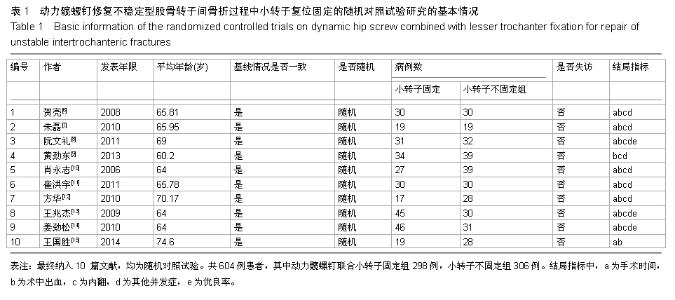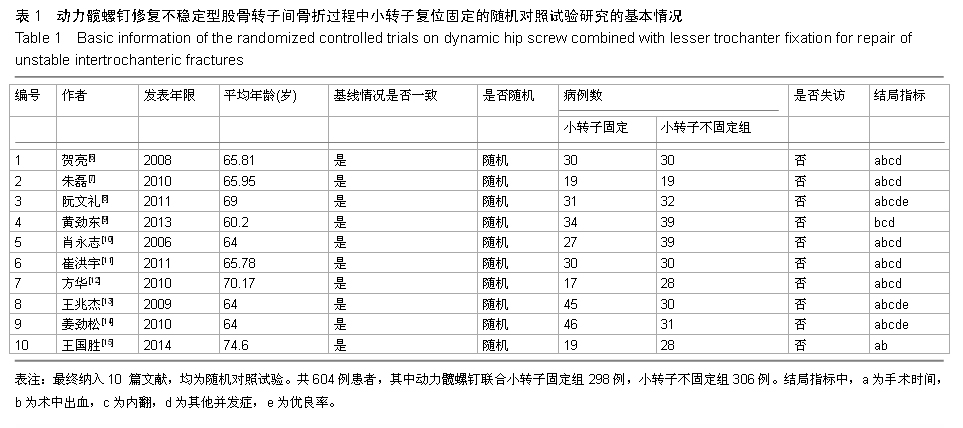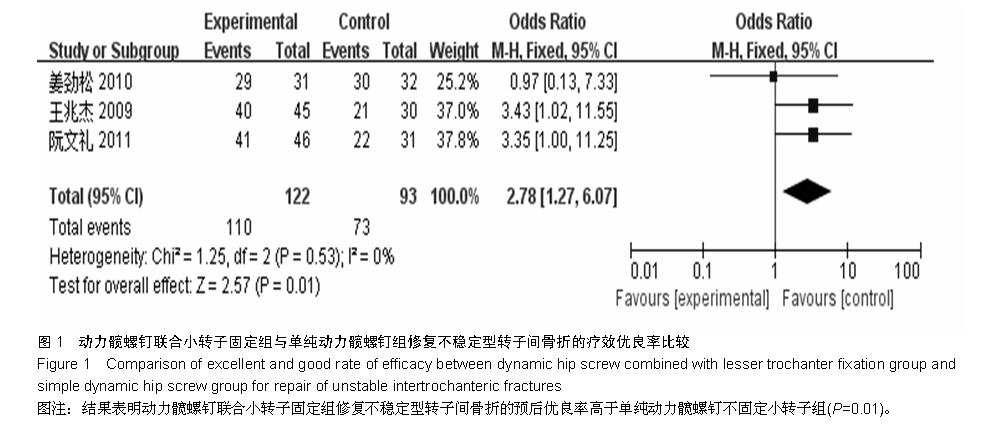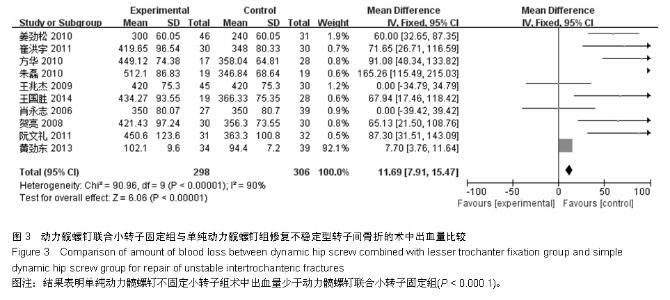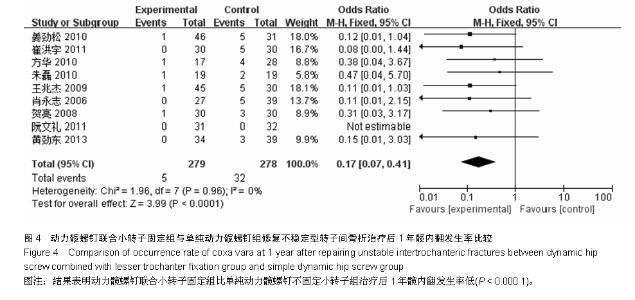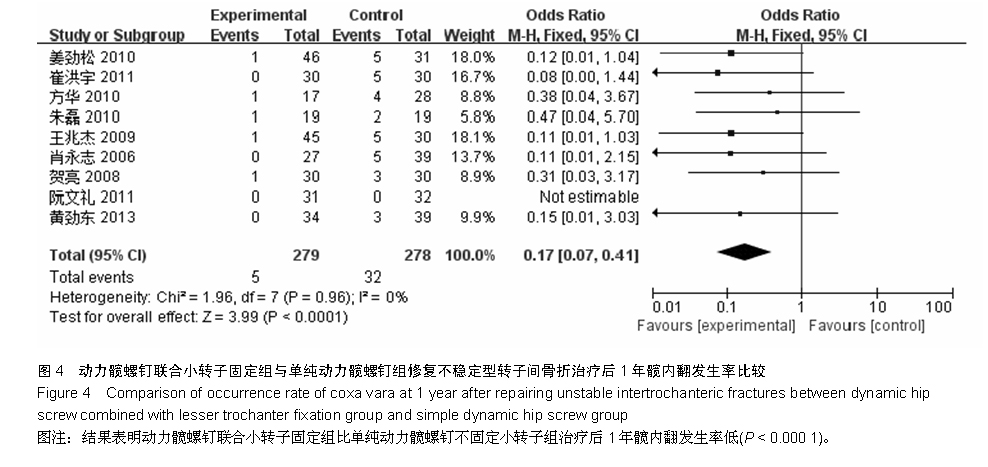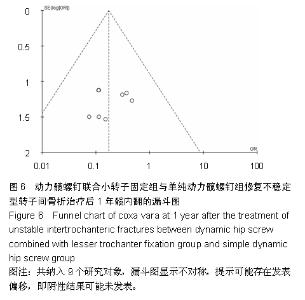Chinese Journal of Tissue Engineering Research ›› 2015, Vol. 19 ›› Issue (31): 5065-5071.doi: 10.3969/j.issn.2095-4344.2015.31.027
Previous Articles Next Articles
Dynamic hip screw combined with reduction fixation of lesser trochanter prevents hip coxa vara after intertrochanteric fractures: a meta-analysis
Lin Zhen-hua, He Jia-nan, Liu Xing-mo
- Department of Orthopedics, the Sixth Affiliated Hospital of Sun Yat-sen University, Guangzhou 510655, Guangdong Province, China
-
Received:2015-05-24Online:2015-07-23Published:2015-07-23 -
Contact:Liu Xing-mo, M.D., Associate chief physician, Master’s supervisor, Department of Orthopedics, the Sixth Affiliated Hospital of Sun Yat-sen University, Guangzhou 510655, Guangdong Province, China -
About author:Lin Zhen-hua, Studying for master’s degree, Department of Orthopedics, the Sixth Affiliated Hospital of Sun Yat-sen University, Guangzhou 510655, Guangdong Province, China
CLC Number:
Cite this article
Lin Zhen-hua, He Jia-nan, Liu Xing-mo. Dynamic hip screw combined with reduction fixation of lesser trochanter prevents hip coxa vara after intertrochanteric fractures: a meta-analysis[J]. Chinese Journal of Tissue Engineering Research, 2015, 19(31): 5065-5071.
share this article
| [1] 吴在德.外科学[M]. 5版.北京:人民卫生出版社,2002:871.
[2] Laohapoonrungsee A, Arpornchayanon O, Phornputkul C.Two-hole side-plate DHS in the treatment of intertrochanteric fracture: results and complications. Injury. 2005;36(11):1355-1360.
[3] Lin PC, Chang SY. Functional recovery among elderly people one year after hip fracture surgery. J Nurs Res. 2004;12(1): 72-82.
[4] Desai SJ, Patel J, Abdo H, et al. A comparison of surgical delays in directly admitted versus transferred patients with hip fractures:opportunities for improvement? Can J Surg. 2014; 57(1):40-43.
[5] Lorieh DG, Geller DS, Nielson JH. Osteoporotic pertrochanteric Hip fractures: management and current controversies. Instr Course Lect.2004;53(5): 441-454.
[6] 贺亮. DHS治疗不稳定型股骨粗隆间骨折中小粗隆复位固定的临床研究[D].福建中医学院,2008.
[7] 朱磊. DHS治疗不稳定型股骨转子间骨折中复位固定小转子的临床研究[D].安徽医科大学,2010.
[8] 阮文礼,曲俊才.不同方法处置股骨小转子在DHS治疗股骨粗隆间骨折中的比较研究[J]. 中国中医骨伤科杂志,2011,19(11): 41-42.
[9] 黄劲东,陈桂华.不稳定型股骨粗隆间骨折治疗中小粗隆骨折的处理[J]. 医学理论与实践,2013,26(20):2722-2723.
[10] 肖永志,杭志刚,刘艳华.粗隆间骨折的后内侧骨皮质连续性重建方法及意义[J].中国矫形外科杂志,2006,14(20):1589-1591.
[11] 崔洪宇.动力髋螺钉配合中药治疗不稳定型股骨粗隆间骨折[D].黑龙江中医药大学,2011.
[12] 方华,黄杰,陈丰,等.动力髋螺钉治疗不稳定股骨转子间骨折:两种方法处理内侧弓的比较[J].临床骨科杂志,2010,13(2): 157-159.
[13] 王兆杰,安荣泽,齐新文,等.小转子复位固定在股骨转子间骨折治疗中的临床意义[J].中国矫形外科杂志,2009,17(4):312-313.
[14] 姜劲松,王秀峰,程俊文,等.转子间粉碎骨折治疗中小转子复位固定的临床意义[J].实用医技杂志,2010,17(4):365-366.
[15] 王国胜,曹力.股骨转子间粉碎骨折小转子复位与未复位对发生髋内翻影响的临床研究[J].新疆医科大学学报,2014,37(2): 195-198.
[16] Sadowski C, Lubbeke A, Saudan M, et al. Treatment of reverse oblique and transverse intertrochanteric fractures with use of an intramedullary nail or a 95 degrees screw-plate: a prospective, randomized study. J Bone Joint Surg(Am). 2002;84(3):372-381.
[17] Felix B, Henry Z, Christoph L, et al. Treatment strategies for proximal femur fractures in osteoporotic patients. Osteoporos Int. 2005;16(2):93-102.
[18] Takigami I, Matsumoto K, Ohara A,et al. Treatment of trochanteric fractures with the PFNA (proximal femoral nail antirotation) nail system-report of early results. Bull NYU Hosp Jt Dis. 2008;66(4):276-279.
[19] 马洪良,彭军,陈懿.解剖型钢板与动力髋螺钉治疗股骨转子间骨折的Meta分析[J].中国组织工程研究,2013,17(43): 7602-7609.
[20] Alobaid A, Harvey EJ, Elder GM,et al. Minimally invasive dynamic hip screw: prospective randomized trial of two techniques of insertion of a standard dynamic fixation device.J Orthop Trauma. 2004;18(4):207-212.
[21] 刘沂. AO内固定技术[J].北京医学,1991,27(6):366-369.
[22] Zhang Q, Chen W, Liu HJ, et al. The role of the calcar femorale in stress distribution in the proximal femur. Orthop Surg. 2009;1(4):311-316..
[23] Stiehl JB, Jacobson D, Carrera G. Morphological analysis of the proximal femur using quantitative computed tomography. Int Orthop. 2007;31(3):287-292.
[24] 黄梦全.有限元法分析后内侧骨折对近端股骨的力学影响[D].南方医科大学,2010.
[25] Kuzyk PR, Lobo J, Whelan D, et al. Biomechanical evaluation of extramedullary versus intramedullary fixation for reverse obliquity intertrochanteric fractures. J Orthop Trauma. 2009;23(1):31-38.
[26] 陈红卫,王子阳,赵品益,等.动力髋螺钉治疗股骨粗隆间骨折并发症原因分析及防治[J].实用骨科杂志,2005,11(5):404-405.
[27] Otsuka NY, Schatzker J. Subcapital fracture of the hip after internal fixation of an intertrochanteric fracture. A case report. Arch Orthop Trauma Surg. 1993;112(2): 69-70.
[28] 黄聚恩,王海景,马高峰,等.滑动加压鹅头钉治疗股骨粗隆间骨折56 例报告[J].中国矫形外科杂志,2000,7(10):1023-1025.
[29] 罗从风,朱越,王磊,等. 459例动力髋螺钉治疗股骨粗隆周围骨折结果分析[J].中华创伤骨科杂志,2002,4(3):188-191.
[30] 王兆杰,安荣泽,齐新文,等.小转子复位固定在股骨转子间骨折治疗中的临床意义[J].中国矫形外科杂志,2009,17(4):312-313.
[31] Saarenpää I, Heikkinen T, Ristiniemi J, et al. Functional comparison of the dynamic hip screw and the Gamma locking nail in trochanteric hip fractures: a matched-pair study of 268 patients. Int Orthop.2009;33(1):255-260.
[32] Li H, Zhang Y. [Research advance of dynamic hip screw internal fixation in treatment of intertrochanteric fractures]. Zhongguo Xiu Fu Chong Jian Wai Ke Za Zhi. 2005; 19(10): 839-842.
[33] Audige L, Hanson B, Swiontkowski MF. Implant-related complications in the treatment of unstable intertrochanteric fractures: meta-analysis of dynamic screw-p late versus dynamic screw- intramedullary nail devices. Int Orthop. 2003;4: 197-203.
[34] Haynes RC, Poll RG, Miles AW, et al. Failure of femoral head fixation: a cadaveric analysis of lag screw cut-out with the gamma locking nail and AO dynamic hip screw. Injury.1997; 5-6: 337-341.
[35] Wu MH, Lee PC, Peng KT, et al. Complications of cement-augmented dynamic hip screws in unstable type intertrochanteric fractures--a case series study. Chang Gung Med J. 2012;35(4):345-353.
[36] Apel DM, Patwardhan A, Pinzur MS, et al. Axial loading studies of unstable intertrochanteric fractures of the femur. Clin Orthop Relat Res. 1989;246:156-164.
[37] Harrington KD, Johnston JO. The management of comminuted unstable intertrochanteric fractures. J Bone Joint Surg Am. 1973;55(7):1367-1376.
[38] Do JH, Kim YS, Lee SJ, et al. Influence of fragment volume on stability of 3-part intertrochanteric fracture of the femur: a biomechanical study. Eur J Orthop Surg Traumatol. 2013; 23(4):371-377.
[39] Kim WY, Han CH, Park JI, et al. Failure of intertrochanteric fracture fixation with a dynamic hip screw in relation to pre-operative fracture stability and osteoporosis. Int Orthop. 2001;25(6):360-362.
[40] Taeger G, Schmid C, Zettl R, et al. [Stable and unstable pertrochanteric femoral fractures. Differentiated indications for the dynamic hip screw]. Unfallchirurg. 2000;103(9): 741-748.
|
| [1] | Xu Weilong, Zuo Yuan, Xin Daqi, He Chenyang, Zhao Peng, Shi Ming, Zhou Boyuan, Liu Yating, Zhao Yan. Selection of modeling methods for acute compressive spinal cord injury: a network Meta-analysis [J]. Chinese Journal of Tissue Engineering Research, 2021, 25(23): 3767-3772. |
| [2] | Fang Yi, Zhao Wenzhi, Pan Deyue, Han Xin, Zhang Lu, He Hongtao, Shi Feng, Tian Tingxiao. Acromioclavicular joint dislocation: how to achieve anatomical reduction, sustained stability and micro-motion [J]. Chinese Journal of Tissue Engineering Research, 2020, 24(5): 796-802. |
| [3] | Wu Ronghai, Zhou Junde, Chen Peiyou, Yuan Liyi, Huang Junlin, Liang Zeqian, Wang Huimin. Meta-analysis of 3D printing-assisted posterior osteotomy for spinal deformity [J]. Chinese Journal of Tissue Engineering Research, 2020, 24(36): 5880-5885. |
| [4] | Feng Chengqin, Zeng Ping, Luo Jun, Liu Jinfu, Huang Jiaxing. Associations between vitamin D receptor gene polymorphisms and osteoarthritis: a meta-analysis [J]. Chinese Journal of Tissue Engineering Research, 2020, 24(33): 5405-5412. |
| [5] | Yan Yan, Zhao Yan, Fu Fanyu, He Haijun. Systematic evaluation and meta-analysis of total hip arthroplasty with three-dimensional printing model in preoperative planning [J]. Chinese Journal of Tissue Engineering Research, 2020, 24(21): 3423-3429. |
| [6] | Fu Jiaxin, Xiao Lianping, Wang Shusen, Li Xiaodong, Han Liqiang, Wang Tonghao. Therapeutic effects of paraspinal approach combined with internal fixation through pedicle of fractured vertebra versus traditional AF screw-rod system for thoracolumbar fractures [J]. Chinese Journal of Tissue Engineering Research, 2019, 23(8): 1177-1181. |
| [7] | Qiu Zhongpeng, Li Ke, Li Gang, Liu Keyu, Du Xinhui, Meng Defeng, Shi Chenhui, Wang Weishan. Different treatments for two-part and three-part proximal humeral fractures by Neer classification: follow-up results analyzed using clinical economics [J]. Chinese Journal of Tissue Engineering Research, 2019, 23(8): 1188-1195. |
| [8] | Ke Wei, Li Ke, Wang Sibo, Du Xinhui, Qiu Zhongpeng, Kang Zhilin, Wang Weishan, Li Gang . Open reduction and plate fixation versus closed reduction and external fixation for distal radius fractures: scores and linear regression analysis [J]. Chinese Journal of Tissue Engineering Research, 2019, 23(8): 1196-1202. |
| [9] | Fan Zhirong, Peng Jiajie, Zhong Degui, Zhou Lin, Su Haitao, Huang Yongquan, Wu Jianglin, Liang Yihao. Suture anchor combined with open reduction and internal fixation versus open reduction and internal fixation for ankle fracture combined with deltoid ligament injury: a meta-analysis [J]. Chinese Journal of Tissue Engineering Research, 2019, 23(8): 1307-1312. |
| [10] | Zhou Yu, Liu Yuehong, Liu Shuping, Chen Xi, Qin Wei, Li Qifeng. Spinal stability of intervertebral grafting reinforced by five or six augmenting screws versus transvertebral grafting reinforced by four augmenting screws for thoracolumbar vertebral fractures [J]. Chinese Journal of Tissue Engineering Research, 2019, 23(4): 505-511. |
| [11] | Li Xianzhou, Wang Qian, Zhang Cunxin . Lumbar spondylolisthesis: status and prospects of implant treatment [J]. Chinese Journal of Tissue Engineering Research, 2019, 23(4): 621-627. |
| [12] | Yin Hao, Zhou Enchang, Pan Zhengjun, Chen Guang, Jiang Hua. Finite element analysis of the four and three cannulated screws combined with buttress plate fixation for the treatment of Pauwels III femoral neck fractures [J]. Chinese Journal of Tissue Engineering Research, 2019, 23(32): 5133-5137. |
| [13] | Zhou Jing, Yang Dan, Wei Meng, Huang Caihong, Zhao Yan. Effects of MOTOmed lower limb function trainer on lower limb function in stroke patients with hemiplegia: a Meta-analysis [J]. Chinese Journal of Tissue Engineering Research, 2019, 23(30): 4913-4920. |
| [14] |
Wang Lei, Li Zilong, Yuan Binbin, Wu Qingwei, Tang Fengming.
Clinical effect of locking plate versus anterograde intramedullary nail in the treatment of adult humeral shaft fractures: a meta-analysis
[J]. Chinese Journal of Tissue Engineering Research, 2019, 23(24): 3924-3930.
|
| [15] | Hao Liang, Zhang Zhonglin, Wang Baodong, Bi Zhenggang. Intertrochanteric fracture of the femur: improvement of internal fixation device, surgical changes and related disputes [J]. Chinese Journal of Tissue Engineering Research, 2019, 23(18): 2927-2935. |
| Viewed | ||||||
|
Full text |
|
|||||
|
Abstract |
|
|||||
